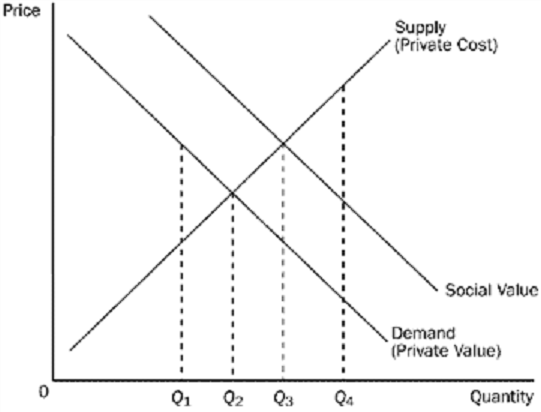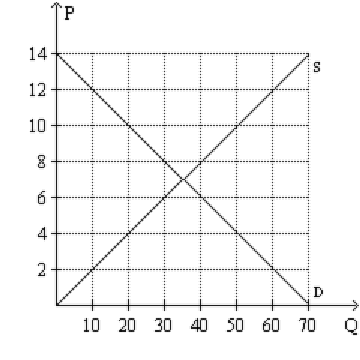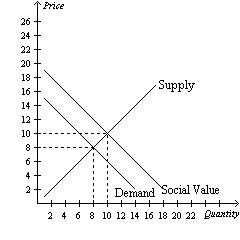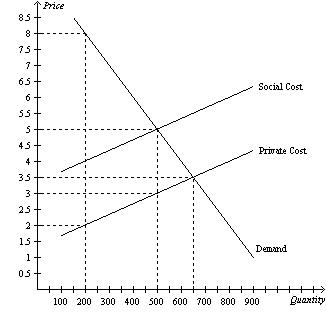College American Economics Worksheet
Description
Question 13 pts
Consumers will be affected if the government imposes a tax on apples because
Group of answer choices
consumer surplus would increase.
the price of apples would increase and fewer apples would be purchased.
revenues for apple growers would decrease.
the government would collect revenue from the tax.
producer surplus would decrease.
Flag question: Question 2
Question 23 pts
In most cases, taxes make markets less efficient because
Group of answer choices
they lower prices for consumers and cause firms to suffer.
they increase firms profits at the expense of consumers.
taxes are perceived as unfair by some taxpayers.
the government often spends tax revenues on programs that some voters dont like.
they reduce consumer surplus and producer surplus.
Flag question: Question 3
Question 33 pts
Taxes cause
Group of answer choices
both consumer and producer prices to increase.
the consumer price to increase but leave producer prices unchanged.
both consumer and producer prices to decrease.
the consumer price to decrease and the producer price to increase.
the consumer price to increase and the producer price to decrease.
Flag question: Question 4
Question 43 pts
After a tax is imposed, the difference between the price that consumers pay and the price that sellers receive equals
Group of answer choices
loss of social welfare from the tax.
per unit tax.
deadweight loss from the tax.
revenue from the tax.
lost profit from the tax.
Flag question: Question 5
Question 53 pts
What is the tax incidence?
Group of answer choices
who pays the tax out of pocket.
how much tax revenue the tax generates.
who bears the burden of the tax.
how the tax revenue from the tax is spent.
government efficiency in providing goods and services.
Flag question: Question 6
Question 63 pts
The DWL from a tax will be smaller when a product has
Group of answer choices
few complements.
many substitutes.
few substitutes.
an elastic demand.
an elastic supply.
Flag question: Question 7
Question 73 pts
The incidence of a tax is determined by
Group of answer choices
which side of the market is less sensitive to a change in price
who pays the tax out of pocket.
whether the supply curve or demand curve shifts as a result of the tax.
how much tax revenue it generates.
how much paperwork there is to complete.
Flag question: Question 8
Question 83 pts
As the size of a tax rate increases, eventually
Group of answer choices
supply can outweigh demand.
willingness to pay can outweigh deadweight loss.
demand can outweigh supply.
deadweight loss can outweigh tax revenue.
tax revenue can outweigh willingness to sell.
Flag question: Question 9
Question 93 pts
If the government puts a tax on the buyers of milk, then
Group of answer choices
buyers will bear the entire burden of the tax.
sellers will bear the entire burden of the tax.
buyers and sellers will share the burden of the tax.
the government will bear the entire burden of the tax.
Flag question: Question 10
Question 103 pts
The decrease in total surplus that occurs after a tax is imposed is called
Group of answer choices
wedge loss.
revenue loss.
deadweight loss.
consumer surplus loss.
Flag question: Question 11
Question 113 pts
Which of the following will decrease when the government puts a tax on a product?
Group of answer choices
the equilibrium quantity in the market for the good, the effective price of the good paid by buyers, and consumer surplus
the equilibrium quantity in the market for the good, producer surplus, and the well-being of buyers of the good
the effective price received by sellers of the good, the wedge between the effective price paid by buyers and the effective price received by sellers, and consumer surplus
None of the above is necessarily correct unless we know whether the tax is levied on buyers or on sellers.
Flag question: Question 12
Question 123 pts
The difference between social cost and private cost is the
Group of answer choices
loss in profit to the seller as the result of a negative externality.
external cost of an externality.
cost reduction when the negative externality is eliminated.
cost incurred by the government when it intervenes in the market.
Flag question: Question 13
Question 133 pts
Why do corrective taxes avoid the inefficiencies of most other taxes?
Group of answer choices
Corrective taxes apply only to goods that are bad for people’s health, such as cigarettes and alcohol.
Because corrective taxes take into consideration the costs to bystanders.
Corrective taxes provide incentives for the conservation of natural resources.
Corrective taxes do not affect deadweight loss.
Flag question: Question 14
Question 143 pts
After a tax is imposed, the price paid by consumers ________ and the price received by sellers ________.
Group of answer choices
increases; increases
increases; decreases
decreases; increases
decreases; decreases
is unaffected; is unaffected
Flag question: Question 15
Question 153 pts
Externalities
Group of answer choices
make markets inefficient.
cause equilibrium prices to be too high.
benefit producers at the expense of consumers.
cause equilibrium prices to be too low.
Flag question: Question 16
Question 163 pts
Which quantity is socially optimal?
Flag question: Question 17
Question 173 pts
To internalize the externality in this market, the government should
Group of answer choices
impose a tax on this product.
provide a subsidy for this product.
forbid production.
produce the product itself.
Flag question: Question 18
Question 1810 pts
Assume a tax of $6 per unit is imposed on this market.
- What will be the new quantity exchanged in this market?
- What will be the new price that buyers pay?
- What will be the new price that sellers receive?
- How much of the tax will buyers pay?
- How much of the tax will sellers pay?
Flag question: Question 19
Question 1915 pts
The government adds a $3 tax to this market.
Calculate the following:
Consumer Surplus =
Producer Surplus =
Tax Revenue =
Total Surplus =
Dead Weight Loss =
Flag question: Question 20
Question 2012 pts
a. What is the external cost?
b. What is the external benefit?
c. Is the private market doing too much or too little in the first
graph?
d. Is the private market doing too much or too little in the second graph?
Flag question: Question 21
Question 213 pts
Suppose a tax was reduced from $6.00 to $3.00. Compared to the $6.00 tax, the lower tax would
Group of answer choices
increase tax revenue and increase the deadweight loss from the tax.
increase tax revenue and decrease the deadweight loss from the tax.
decrease tax revenue and increase the deadweight loss from the tax.
decrease tax revenue and decrease the deadweight loss from the tax.
tax revenue would stay the same and decrease the deadweight loss from the tax
Get your college paper done by experts
Do my questionPlace an order in 3 easy steps. Takes less than 5 mins.







Leave a Reply
Want to join the discussion?Feel free to contribute!